Radio W4KAZ Thanks for stopping by the virtual KazShack. Feel free to comment - I often approve them.
|
By w4kaz, created on 2008.07.15 at 21:59:21 | last changed on 2008.08.01 at 06:48:04 | The proof is in the pudding.
In the grand scheme of contesting, I’m just an ankle biter, but when one of the Big Dawgs barks, it’s worth noting. W4PA posted some notes in his journal, dated 7/14/2008, that confirm every speculation made by folks who argue for making CW Skimmer fall into the “Assisted” category. Scott operated the IARU contest with CW Skimmer up and running(actually he used six).
Quoting W4PA, (emphasis added is mine):
- “”Does it work? Absolutely.”
- “”It looks just like packet spotting””
- “”The callsign quality was good, I’d say 90% of the calls spotted were correct“”
- “”The Skimmers also alerted me to the 10 meter opening in progress””
- “”On 20 meters early on I had 600 available calls to be worked at one point spotted by the Skimmer””
- “”Does it look and feel like packet? Definitely“”
- “”If I didn’t know what it was, I would have assumed I was looking at packet spots“”
- “”Is it different than unassisted traditional single op? Sure.””
- “”Is it an advantage over unassisted single op? No question.””
- “”It may even be better than packet, because it gives you ALL the callsigns for the whole band. “”
Reading what I’ve written previously, you might come to the erroneous conclusion that I think skimmer is bad. I don’t. I just think the rush to allow it in the ‘unassisted’ category is bad. The tool itself is inanimate. It is the ethics of thecategorizationof its use that I question. Read W4PA’s whole post.
It walks like a duck, quacks like a duck, makes messes in the grass like a duck….it’s a duck.
By w4kaz, created on 2008.07.15 at 06:26:19 | last changed on 2008.07.15 at 12:58:19 | Scott, W4PA, has posted a couple of hints that the Charlotte hamfest will also be relocating to new digs for their next show in 2009. Scott indicates the Carrabus Arena will be their new home. First Shelby, now Charlotte.
This will be good news for those of us driving in to their ‘fest from the RTP/Raleigh/Durham area, and maybe for the Triad folks too. A Carrabus arena location will cut almost an hour off the drive from this area. The Carabus facility is almost brand new – another small bonus.
The Charlotte move is being caused by the sale of the Charlotte Merchandise Mart to a church. The club has little recourse. I hope they are able to make the shift to the new location smoothly. I’d recommend that they update their website to get the word out ASAP. It still has 2008 info with the old location. Perhaps its all still being finalized, and I’m jumping the gun.
I’d bet that W4PA has the straight word, since he’s a rep for one of their better customers, TenTec.
By w4kaz, created on 2008.07.11 at 07:40:29 | last changed on 2008.07.11 at 20:26:15 | K8ND has acollection of SO2R shack photosthat should help with getting layout ideas. Some are simple and some are elaborate. Some layouts appeal to me for different reasons.
I like N4TZ’s layout because the Vee shape allows some access to the rear of the gear. My shack space was too limited for this, so my own design is on wheels – I can pull the whole kit away from the wall for snaking wires.
I also like the K3PP shackbecause I like the simplicity and versatility of the small shelves for vertical gear stacking. My own cabinet is somewhat less versatile, but good enough for now.
By w4kaz, created on 2008.07.09 at 06:32:13 | last changed on 2008.08.03 at 11:30:43 | I spent some time re-arranging the station area in the basement cubby-hole after unloading the jed-clampett-mobile(my stuffed to the gills truck) in the days following Field Day. Here’s a picture to remember it by, because I’m sure it will soon again be covered by several years of miscellaneous unrelated items. Things seem to find their way their over time.
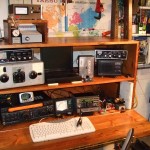 Here’s what the operating position is looking like after I re-sorted everything out after field day of 2008. On the bottom row, the FT-920, Diawa wattmeter, and Elecraft k2/100 w/KAT100. On the next level up, an MFJ tuner on top of MOAT, the “Mother of all Tuners”. centered is the junker laptop and K9AY switch, then the Yaesu SP-8 speaker with another MFJ tuner on top. On the top of the cabinet is the “wishful thinking”, a Ham-II control box(attached to nothing) and the switch box for an incomplete home brew remote switch project. Here’s what the operating position is looking like after I re-sorted everything out after field day of 2008. On the bottom row, the FT-920, Diawa wattmeter, and Elecraft k2/100 w/KAT100. On the next level up, an MFJ tuner on top of MOAT, the “Mother of all Tuners”. centered is the junker laptop and K9AY switch, then the Yaesu SP-8 speaker with another MFJ tuner on top. On the top of the cabinet is the “wishful thinking”, a Ham-II control box(attached to nothing) and the switch box for an incomplete home brew remote switch project.
The desk itself is something I designed and built five years ago. Its major shortcoming is the lack of space for a monitor. I was previously using a side cart for the computer and monitor. Since I now have an old laptop for my logging, I have it included in the desk set up. The side cart is now gone, but I will build one to match the desk at some point. The Ham-II controller is a place saver, since I don’t have any tower or rotatable antennas up….yet.
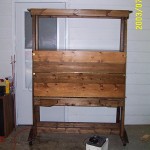
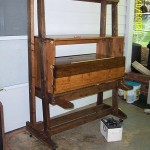 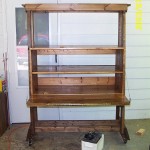 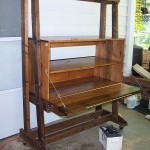
Top: desk with fold down door closed. bottom left: side view with one panel of desk surface opened. bottom center: front view with desk top opened. bottom right: side view opened
The desk itself worked out very well otherwise, since my operating area is so physically limited. It’s nice to be able to fold up the desktop. Since the desktop also acts as a fold-up door, I can close and lock it up if bneeded. The whole kit is on heavy duty casters, so I can roll the entire station around fairly without needing to be too careful. It DOES help to unplug everything before trying to roll off with it. 😉
In use, the desk level shelf and the shelf above are in easy arm’s reach. Anything on the top of the box is a stretch, so its somewhat inconvenient to put tuners and antenna switches up there. The very topmost shelf is mostly out of reach for me, so use it for storage. The area below desk level is perfect for the APC line conditioner, power supplies, and the fire extinguisher. The desk top is itself held by permanently attached steel cables, and two fold out brackets below the desktop. I wasn’t up to the challenge of pocketed brackets, so they are hinged to the front of the frame. The desktop is at 27 inches, which I find the best height for me, and it has a slight slope downward when open. Just enough slope that pencils will roll off. Grrrr. I did that on purpose. Sometimes I think it was a mistake, but it makes long periods of operating and logging comfortable.
The photos don’t show it very well, but the desk is stained in two different tones. It was a carpentry experiment that worked. If I can find the plans I drew up for it, I’ll post them. The construction is simple, using common dimensions of lumber available from any big box here in the US. The frame is constructed of 2×4 and 1×4 material.
The case is actually aseparatepiece, just sitting in the frame. It’s weight is enough to hold it in, as long as no one is goofy enough to try and sit on the desktop when its open. It is constructed of 1×6 and 1×4 lumber, some of which is edge joined to make wider pieces. All of the lumber is pine, so it tends to scar easily. I’ve been touching up the dents and dings with matching stain, and I like the lived in look the markings add to the piece.
With the desktop closed the whole thing is just over two feet deep, so it occupies a relatively small footprint. It is a bit less versatile than a larger flat desktop, but I needed a space saving solution. If I ever get the chance to move to a larger area, I’ll have a new project – matching extension pieces.
By w4kaz, created on 2008.07.07 at 09:55:09 | last changed on 2008.07.06 at 10:26:11 | I picked up this link up from Scot, KA3DRR and RadioDawg over at the shackadelic. There’s a project going on to port TR over to Windows. The product appears to still be in beta testing, and I understand there are still some outstanding issues with CAT control for certain radios.
The hardware requirements appear to be relatively modest. Leisure funding isdisappearingas college tuition for the eldest son kicks in for the fall of 2009. If I can run it on my old clunker CPUs, it will be worth playing with.
I have been using Writelog since returning to radio, and I am happy with it. It is a good program, and written efficiently enough to run on my junker PC’s. I will continue to buy support for it, as most of the open source software I have used is bloatware, requiring far more CPU and memory resources than the modest tasks of logging actually require. It just rubs my professional feathers the wrong way.
But the major reason I’ll keep supporting Writelog is that I don’t want to see the logging software market dominated by any one vendor. I’m willing to put my money where my mouth is on that issue. It’s a small price to pay for a job so well done.
That’s all irrelevant to the TR4W project. I’m glad to see this being ported to a windows platform. I’ve never really tried it out, but TR certainly has a core group of True Believers.
By w4kaz, created on 2008.07.06 at 07:39:54 | last changed on 2008.07.07 at 07:09:41 | Several members of the NC/East chapter of PVRC(the NC Contesters Club, NR3X) put together another small scale field day operation for 2008. Operating as N4PY, we built stations on the campus of Royal Elementary just south of Louisburg, NC. Our operations in the 3A class netted 1808 CW Q’s, 511 SSB Q’s, for a total of 2319 QSO’s and an expected score of just above 8800 points. (Note: Link to Carl, N4PY’s software site, the N4PY discussion group, and the eham review of the N4PY rig control software.)
The set up was moderately simple. All antennas were simple wires of one sort or another. For 2008 we choose to operate as 3A, with a full time 40m station, an 80m/20m station, and a 15m/10m/vhf station. The 15m/10m station turned out to be far more productive than we had any real reason to expect given the current sorry state of the sunspot cycle.
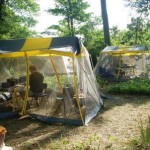 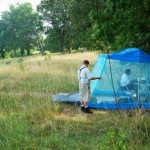
Left: 40m foreground, 80m/20m background Right: W4KAZ removing shade screen as W4MY works 15m
For antennas, we used a Vee beam(east/west) with 266 foot legs on 80m/20m. The 40m station relied on another east/west Vee beam with 200 foot legs, supplemented with a hastily constructed but poorly tuned 40m dipole aligned at 90 degrees to the favored direction of the Vee beam. The 15m and 10m antennas were simple dipoles. All antennas were constructed on site – a cause for concern as 1800z approached….!
We had the core group of operators, N4PY, N4YDU, W4KAZ and K4CZ, all returning from 2007’s operation at the fire observation tower. We were joined this year by N4GU and W4MY. KB4DNX was the the only participant who is not a PVRC member, and although Dale’s time was very limited, he contributed to the effort.
The site chosen was very close to ideal for field operations. As you might imagine from our choice of Vee beams for antennas, the Royal elementary campus has a very large unused field to its rear. The divider between the school playground and the adjoining fallow field is a gentle hill with a small group of shady oak trees at its center. The field and playground are lined on one side by a long line of tall trees. The properties to either side of the school campus are either farmland or wooded, so there were no nearby neighbors to annoy(or generate RF noise!). There was even a small space formed by a pair of boulders, well suited for placing the generator and attenuating the generator noise. It was very close to ideal for a field operations site. The high temperatures were somewhat offset by moderate humidity levels and a constant strong “breeze” that at times gusted and ruffed up the stations.
Despite some fairly routine “technical difficulties”(i.e., Murphy), we were on the air very close to the 1800z start time. Everyone pitched in to keep progress going, despite the uncomfortable WX. Thanks to N4PY, we were even able to have a bit of lunch before operations commenced. Our 15m station earned its keep right out of the gate, although it tapered off as evening approached. We didn’t have blistering rates on any station, but all had a steady stream of QSO’s trickling in when they were manned.
W4MY arrived straight from work in the early evening Saturday, bearing a much appreciated box of sandwiches and, more importantly, an infusion of enthusiasm needed for the second half of operations. N4GU returned the favor Sunday morning, returning to the site bearing edible gifts.
Our best single station hour was actually on the 10m station, when N4YDU caught the opening there Sunday morning. In the other station area, two sets of Dunestar filters belonging to N4GU were 100 percent successful at keeping the neighboring 40m and 80m/20m stations out of one another’s way. Despite the close proximity of the two Vee beams, we never heard a peep of interference.
One of the weekend’s highlights was working CT1HZE on 6 meters, and the poor guy had to work a pile-up of N4PY FD operators as everyone in the 6M shack quickly passed the mike around to snag the DX QSO on 6m.
Everyone pitched in and the group worked well as a team. It was a great weekend, even with the high heat, high weeds, high poison ivy, and high tick count. All of those things were far outstripped by high spirits, comradery, good humor, and not a drop of rain to dampen spirits. A bunch of QSO’s was icing on the cake.
Next up for some of our group is another run at the IOTA NA low power expedition plaque by N4YDU and W4KAZ, who are being joined this year by K4CZ. Look for “N4A” from NA-067.
edited 7/6/2008, 1710z, kaz
By w4kaz, created on 2008.07.05 at 06:52:22 | last changed on 2008.07.07 at 07:08:26 | On Friday, June 27th NOAA added a comment to the “Solar Cycle 24 Prediction Issued April 2007”. The comment basically says “that’s our story, and we’re sticking to it”. They may have fudged the graphs a bit toaccommodatethe year’s observations, but the predictions remain the same.
Boy, I sure hope we hit that steep curve for the upper end of the “big cycle” prediction, rather than the low end of the “teeny cycle” prediction. It was fun to hear short skip openings on 15m and 10m over FD weekend. I was born decades too late to catch the “hard sky” of 1958.
THAT would be FUN.
By w4kaz, created on 2008.07.04 at 08:55:07 | last changed on 2008.07.04 at 08:55:48 | Picked this up off theTower Talkreflector. Rohn Tower has been sold by Radian to a company in Peoria called O’Brien Steel. Radian has themselves been recently acquired by Montreal based Prestige Telecom.
So ownership of Rohn returns to Peoria. I hope that is good news for the employees as well as their niche market customers – hams.
By w4kaz, created on 2008.07.03 at 08:09:08 | last changed on 2008.07.06 at 09:58:56 | The final tally for the 2008 class 3A operation as N4PY is together. We had 1808 CW QSO’s and 511 QSO’s.
(7232 CW QSO PTS + 1022 SSB QSO PTS) + 500 BONUS = 8,754
One of the highlights was probably working CT1HZE on 6 meters. The guys in the 6m shack got a lift out of that.
By w4kaz, created on 2008.07.02 at 09:36:17 | last changed on 2009.03.23 at 18:22:13 | I see that Ten-Tec’s Summertime Used Gear Sale is on. They are re-selling OMNI-VI’s and Orions taken in as trade-ins. I’ve always liked the Omni VI. Its a solid CW rig with a great receiver. Sweet.
I am also fresh off a weekend using an Orion on bands loaded with Field Day operators. The Orion is also a sweet radio. It is a great S&P contest radio. You can set the CW bandwidth to a vary narrow setting and work stations every 250hz all the way up and down a band. Zero detectable ringing, even with the bandwidth cranked down to about 160hz.
Too bad my shack is not bigger. I’d sure like to have custody of an Omni VI Plus for three or four years.
I’ve always been somewhat hesitant to buy used gear, but the beauty of this sale is that the rigs have been checked out by factory. Plus they are tossing in a credit on an accessory item, a microphone, and picking up the shipping tab.
NO – I don’t get any kickbacks….
edit, 11:30 am 7/2/08: I’m also fresh off using the Omni VII, another fabulous radio. The Omni VII QSK is top notch. I like running with the side tone set to a low level, it makes the quality of the QSK jump out. I like the ergonomic design of both the Orion and Omni VII. Both radios are easy on the ears. But because of its small size and tolerance for low voltage, I’m happy with my choice of the Elecraft K2. It too is a fine radio.
|
|






